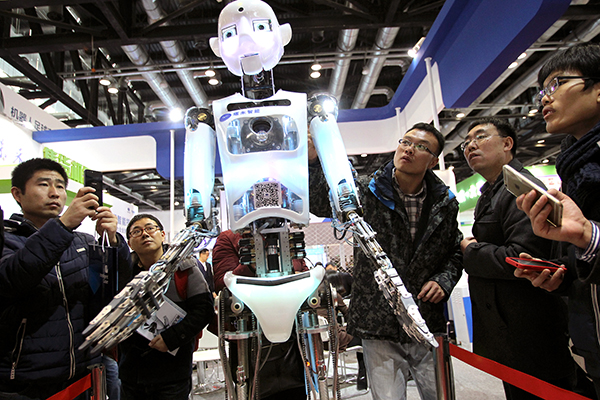'Created in China' to be the new label
- By George N. Tzogopoulos
 0 Comment(s)
0 Comment(s) Print
Print E-mail China.org.cn, January 4, 2018
E-mail China.org.cn, January 4, 2018
Most people in the West thinking of the Chinese economy tend to associate it with the "Made in China" label. This is a natural tendency because numerous products they are consuming or using in their everyday life are indeed fabricated in China.

However, future developments might challenge conventional wisdom. The "Made in China" label could become a "Created in China" one. This means that the country will be able to make the difference by also relying on qualitative production.
The change is not happening overnight. The Chinese administration is setting long-term goals and meeting them slowly and patiently. Since 2015, it has strongly encouraged intelligent manufacturing. Innovation is the key element to guarantee success for generations to come.
Through critical investments and the takeover of foreign companies, China is acquiring the necessary technological "know-how." However, this is not necessarily sufficient. So, the country is simultaneously laying emphasis on research and development for its own technological achievements.
Several examples can be given: from robotics in medicine to clean energy, mobile coordination and sophisticated Internet linkages. And from automated container terminals in ports to the construction of aircraft, aircraft carriers and exploration satellites.
The policy of reform is interwoven into China's shift from a country with double-digit growth rates to one enjoying lower rates, but stability and quality. In that regard, President Xi Jinping is stressing the idea of "supply-side reform." The principal objective has been to reduce overcapacity and corporate costs.
The head of the Asia Pacific division of JPMorgan Chase, Jing Ulrich, recently commented that this "reform actually has come to fruition" because even traditional industries are becoming profitable once again.
General numbers show transformation of the Chinese economy is on track. Its GDP expanded 6.9 percent year-on-year in the first three quarters of 2017, with a slight decline of 6.8 percent in the third quarter. This was the ninth straight quarter for China to see economic growth of at least 6.7 percent.
For its part, the World Bank is optimistic. Only a few days ago, it raised its forecast for the country's economic growth in 2017 to 6.8 percent from the 6.7 percent it projected in October, as personal consumption and foreign trade supported growth.
Another necessary presupposition for the strengthening of high-quality development is the introduction and improvement of relevant mechanisms. According to the statement of the annual Central Economic Work Conference they include indicators, standards, statistical and performance assessment systems.
The prevention of financial risks, and tackling illegal activities in the financial industry are of additional significance. A more efficient regulatory screening seems to be emerging. Initial results are encouraging. For instance, local officials responsible for misconduct and irregularities related to local government debt are regularly being identified and detained.
Symbolically, 2018 is important as it marks the 40th anniversary of China's reform and opening up policy. These elements have turned the country into the world's second-largest economy. The expansion of those elements by the current Chinese administration in recent years in parallel with the launch of new policies will yield equally satisfactory results.
The ongoing mission is perhaps even more complex, as requiring difficult decisions under time pressure. Two years ago, Western commentators were largely anticipating the bursting of a "Chinese bubble," but the Chinese administration has proven them wrong.
Of course, problems do exist. But what matters more is the determination to look at the reality and improve the situation than to only predict devastating scenarios.
This year of 2018 is not the one in which the "Created in China" label will be definitely established. However, it is the year during which the systematic, hard work towards this goal will be continued. China's qualitative and sustainable growth is not a theory. It already exists.
George N. Tzogopoulos is a columnist with China.org.cn. For more information please visit:
http://www.china.org.cn/opinion/GeorgeNTzogopoulos.htm
Opinion articles reflect the views of their authors, not necessarily those of China.org.cn.






Go to Forum >>0 Comment(s)